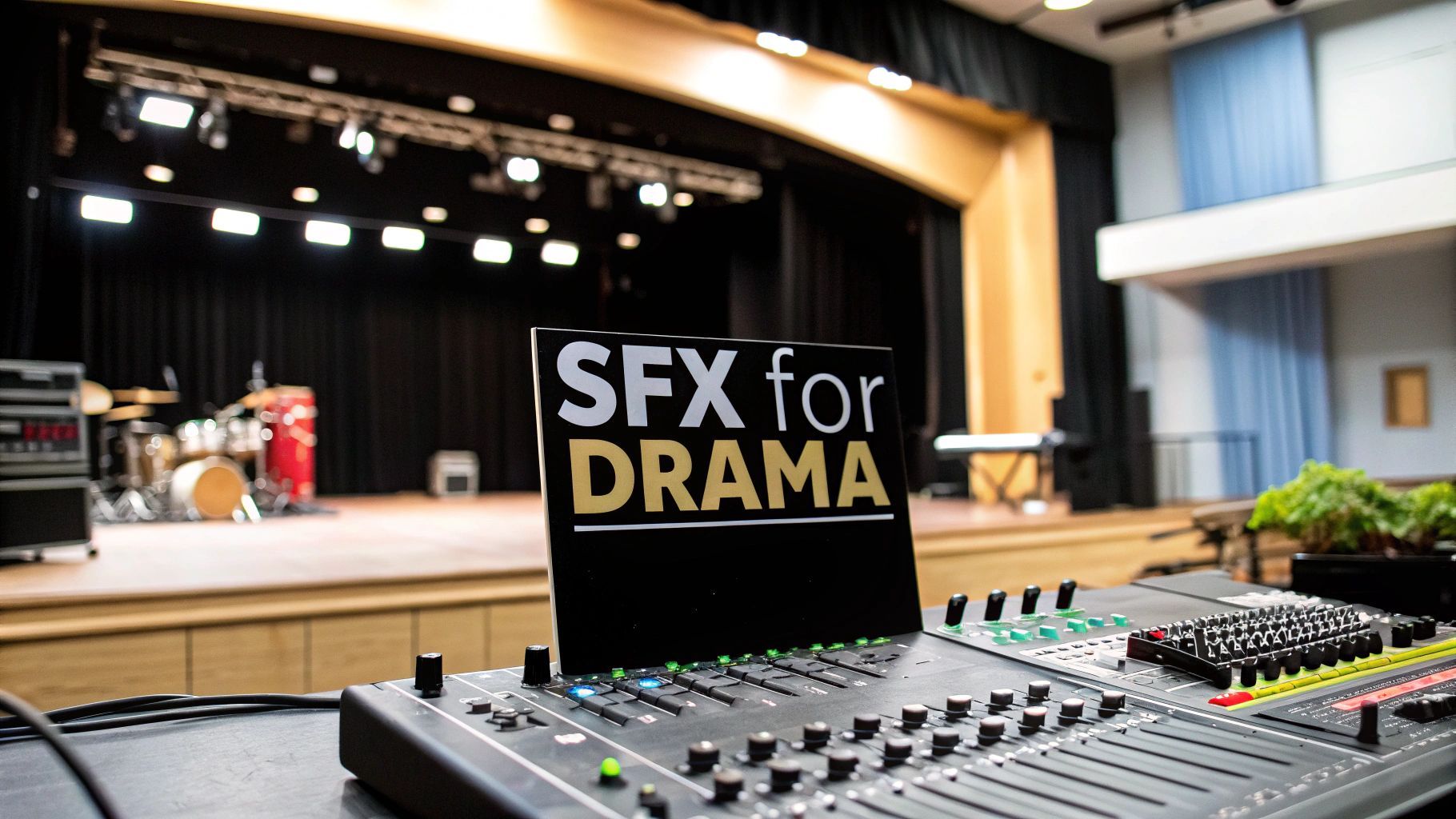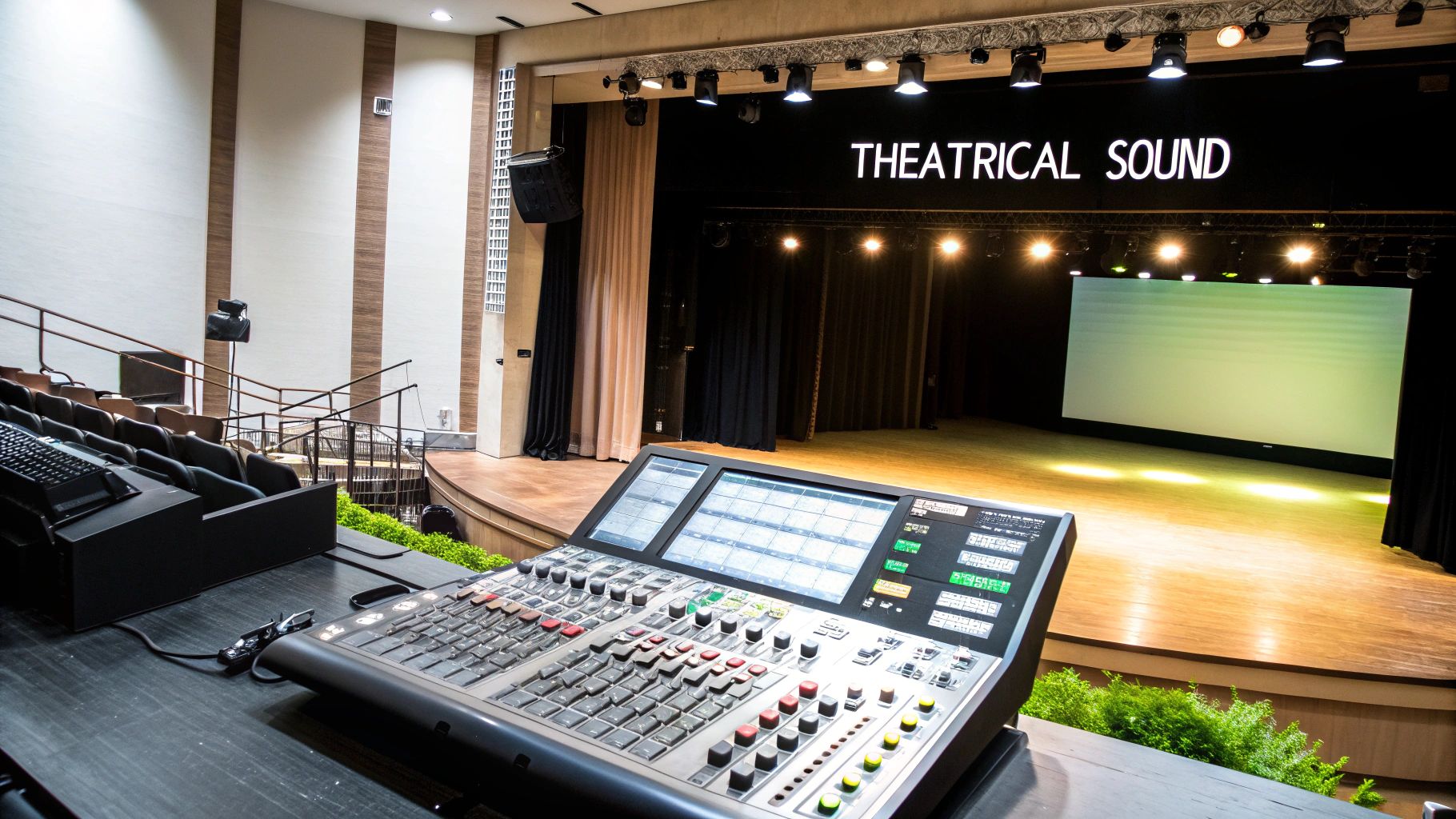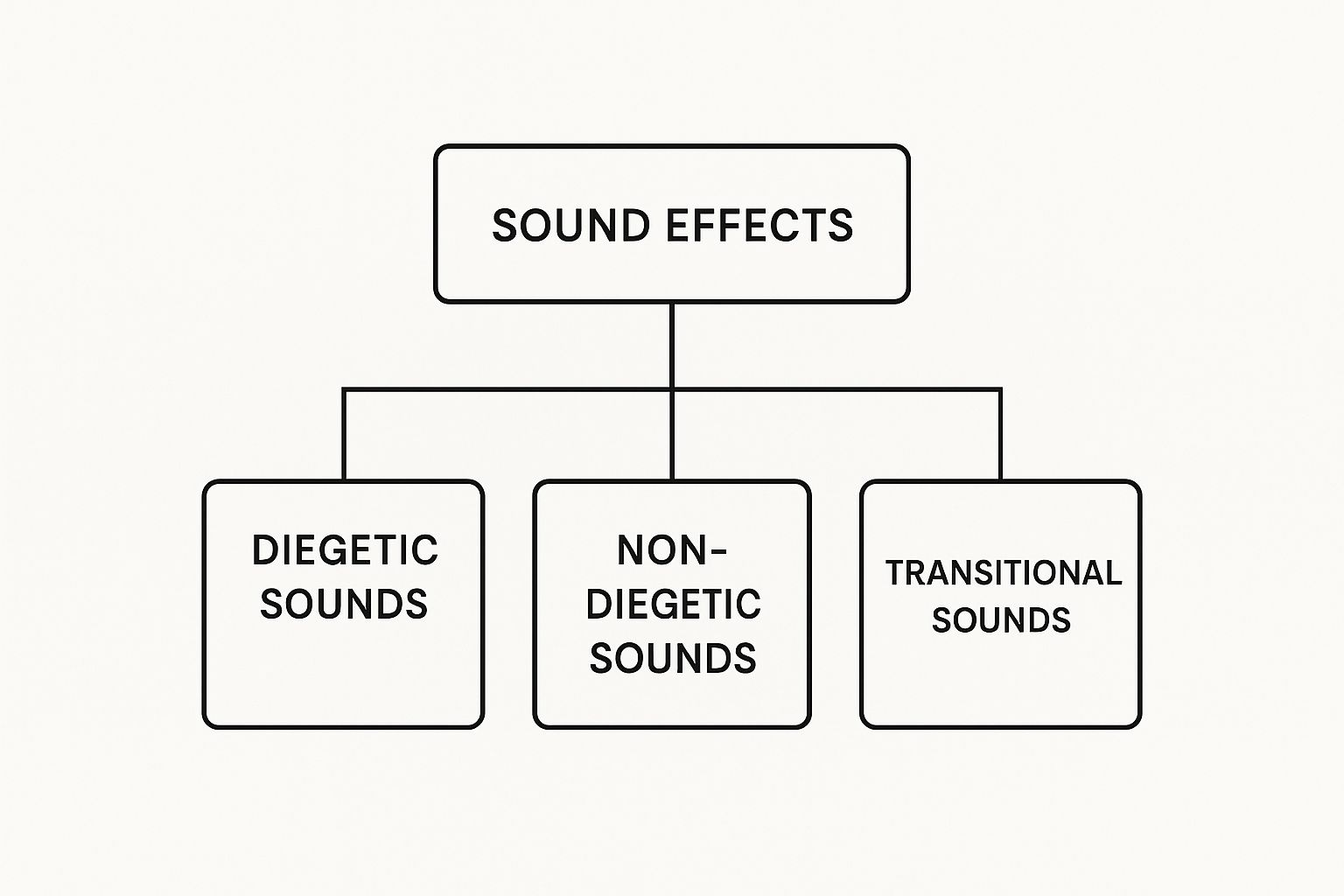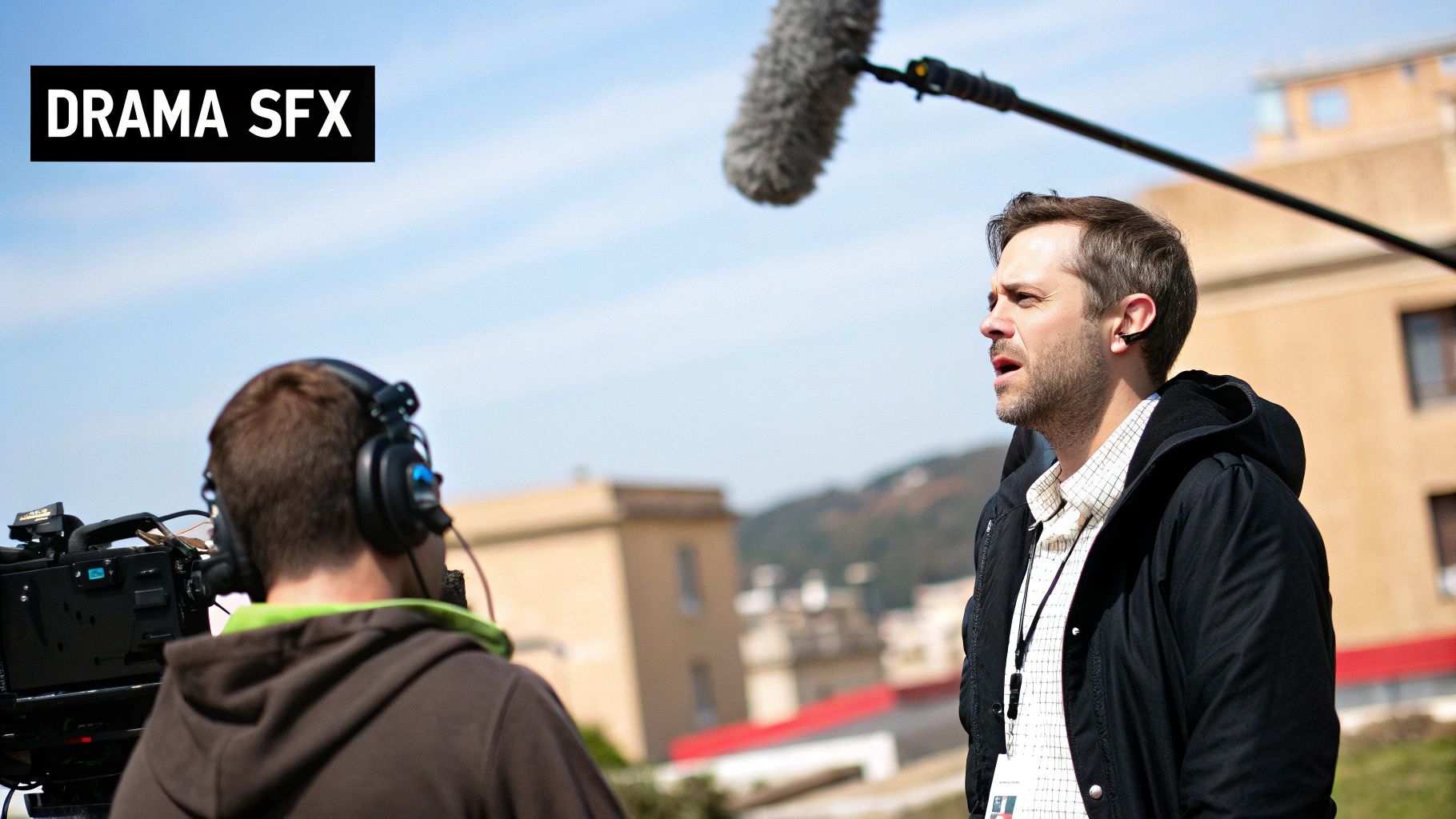
Sound effects in drama are so much more than just background noise. They're a powerful, unseen character in every story. These audio cues—from a subtle, humming atmosphere to a sharp, shocking impact—are meticulously chosen to build worlds, dial up audience emotions, and create nail-biting suspense, often before a single word is spoken.

Think of a sound designer's toolkit like a director's visual palette. Just as a filmmaker uses lighting and camera angles to frame a scene, a sound designer uses audio to steer the audience’s emotional and psychological journey. A quiet, empty room isn't just silent; it’s filled with the low hum of a distant refrigerator or the faint whistle of wind under a door. Each sound tells its own story of isolation or unease.
These carefully sculpted audio landscapes are fundamental to building a believable world. The specific sound of footsteps on gravel versus on a marble floor instantly tells you about the setting and even a character's social status. This entire practice of weaving audio into a narrative is known as sound design, a discipline that blends pure artistry with deep technical skill. If you want to dig deeper, you can learn more about what is sound design and see how it works as the architectural blueprint for a story's auditory world.
Sound speaks a language our subconscious understands instinctively. It works just below the surface, triggering emotional responses far faster than visual cues can. This makes sound effects for drama an incredibly potent tool for any storyteller.
For instance, a low-frequency drone creeping into a scene can create an immediate sense of dread, putting the audience on edge without them even knowing why. On the other hand, a delicate, high-pitched chime might signify a flashback or a fleeting moment of hope. This kind of emotional direction is the very heart of dramatic sound design.
Audio dramas are the ultimate test of this principle. Relying entirely on voice acting, music, and sound effects, the medium forces creators to tell a complete, gripping story through sound alone. It’s perfect proof of how powerful a well-designed soundscape can be.
The real job of dramatic sound effects goes way beyond just making things sound realistic. They serve specific narrative purposes that transform a simple sequence of events into a truly immersive experience.
Ultimately, every sound—and every moment of silence—is a deliberate choice. In this guide, we’ll deconstruct these choices, exploring the key pillars of dramatic audio, the psychology that makes them work, and the modern tools that help bring these auditory worlds to life.
To really get a handle on sound effects for drama, you first need to understand the basic building blocks that create a believable, immersive world for your audience. Think of it like a painter's palette. You don't just have one color; you have primary colors, secondary tones, and subtle shades that all work together. In sound design, those primary elements are Ambiance, Foley, and specialized SFX.
Each one has a specific job, whether it's grounding the audience in a real-world location or dialing up the emotional tension. When you learn how to layer these elements properly, a scene goes from feeling flat and lifeless to being a rich, three-dimensional experience.
And this skill is more valuable than ever. The global market for sound effects services hit about USD 2.5 billion in 2023 and is expected to skyrocket to nearly USD 4.8 billion by 2032. This explosive growth shows just how critical high-quality sound is becoming in film, TV, and even theatre. With North America's massive entertainment industry making up around 35% of that market, the demand for talented sound designers isn't slowing down. You can dig into this trend over on dataintelo.com.
To help you get started, here's a quick look at the main sound effect categories and how they fit into a dramatic production.
| Sound Category | Primary Function | Common Examples |
|---|---|---|
| Atmosphere/Ambiance | Establishes the setting and mood. Grounds the scene in a specific time and place. | City traffic, chirping crickets, distant sirens, the hum of an office. |
| Foley | Adds realism by syncing sounds to character actions. Makes movements tangible. | Footsteps on gravel, the rustle of clothing, a key turning in a lock, a cup on a saucer. |
| Transitions/SFX | Guides the audience's emotions and bridges scenes. Not heard by characters. | Musical score, whooshes, risers, stingers, sound bridges. |
Each of these plays a vital role in building the complete auditory experience that pulls an audience into the story.
Simply put, diegetic sound is anything that exists inside the story's world. If the characters on screen can hear it, it’s diegetic. This is the foundation of realism, creating a shared environment for both the characters and the audience. It’s the sound of the world they—and we—inhabit.
This includes obvious things like dialogue, but it also covers all the subtle atmospheric sounds that define a location. When a character steps into a busy coffee shop, we expect to hear the clink of ceramic mugs, the hiss of the espresso machine, and the indistinct chatter of other patrons. Without these sounds, the world feels empty and fake.
Key Takeaway: Diegetic sound makes the story's world feel real. Its job is to establish a sense of place and authenticity, making the fictional environment tangible. A scene without it feels sterile and unconvincing.
Sound designers typically break diegetic sound down into two main subcategories:
While diegetic sound builds the world the characters live in, non-diegetic sound is purely for the audience. The characters can't hear it. It exists completely outside the story's reality, serving to guide the viewer’s emotions and help structure the narrative.
This is where a lot of the magic happens in drama. The most obvious example is the musical score. A soaring orchestral piece during a triumphant moment or a single, sad piano key during a quiet moment of heartbreak are powerful non-diegetic cues that tell the audience exactly how to feel.
This infographic gives a great visual breakdown of how these sound layers work together.

As you can see, it clearly separates the sounds the characters hear from the ones only the audience does, showing how they combine to shape the overall experience.
Transitional sounds are a special kind of non-diegetic effect designed to smooth over the jump from one scene to the next. A subtle whoosh, a rising swell of music, or a sharp swoosh can connect two different shots, making the edit feel deliberate and fluid. Think of them as the auditory glue that holds the story together, guiding us through shifts in time and location without feeling jarring.

This is where we move past the technical stuff and get to the heart of what sound design is all about. It’s the difference between knowing what a sound is and understanding why it can make an audience lean in with suspense or jump out of their seat. Sound has a direct, almost primal, connection to our subconscious, hitting us with emotion faster than any visual ever could.
Tapping into that connection is the real art. It's about creating a unique sonic language for your story, where certain sounds become emotional shortcuts for the audience. This isn’t just about making a scene sound realistic; it’s about making it feel real.
Our brains are wired to react to sound in specific ways, a hangover from our survival instincts. Think about low-frequency sounds—a distant rumble, a deep, pulsating drone. They often signal something big, something unknown, and potentially dangerous. This is precisely why a low, resonant hum is a classic go-to for building a sense of impending doom.
On the other end of the spectrum, high-pitched sounds cut through everything to grab our attention. A sudden, sharp chime can signal a moment of clarity, a new idea, or a ghost of a memory. Volume is your amplifier for emotion. Slowly cranking up an unsettling sound can create an unbearable build-up of tension, while a sudden cut to dead silence can be far more shocking than any loud bang.
"It was important to avoid simply stacking layers and ending up with a steady din... all that sound is carefully composed to enhance the setting and the story best." - Bryan Parker, Supervising Sound Editor on The Pitt.
Parker’s point is critical when using sound effects for drama: every sound needs a reason to exist. True chaos isn't just a wall of noise; it's a carefully orchestrated selection of specific, emotionally-charged sounds that create a controlled sense of disorder.
Just like a composer gives a character a recurring musical theme, a sound designer can assign them a specific sound effect. We call this a sound motif, and it’s a brilliant way to anchor characters and themes in the audience's mind without a single word of dialogue.
Let's say a character is haunted by a traumatic event. Every time they have a flashback, maybe we hear the faint, distorted ticking of a clock or a specific, unsettling whisper. That sound becomes their emotional signature. Before long, the audience will associate that sound with the character's internal pain, and you can trigger a complex emotional reaction just by playing that single effect.
One of the most potent tools in your emotional toolkit is contrast. A scene filled with the chaotic noise of a heated argument—overlapping shouts, a slamming door, shattering glass—is designed to feel stressful and overwhelming. The sheer volume and complexity of the sounds throw the audience right into the characters' agitated state.
But the moment that truly lands the punch is often the one that follows. The deafening silence after the argument is over can feel heavier and more loaded with tension than all the noise that came before. This empty space gives the audience a beat to process what just happened, letting the emotional weight of the scene sink in deeply.
This dynamic plays out beautifully in three-dimensional audio. To really get a handle on how sound placement can crank these moments up to eleven, check out our guide on what is spatial audio. By using the entire spectrum of sound—from a complete sensory overload to profound quiet—you can guide your audience on an unspoken emotional journey that tells the story all on its own.
Knowing the theory is one thing, but getting your hands dirty is where the real artistry begins. Directors and sound designers rely on a handful of core techniques to build the kind of compelling soundscapes that make a drama feel truly alive. These are the methods that separate an amateur production from something that feels polished and professional.
It's about so much more than just dropping a sound effect in to match an action on screen. Great sound design is about building a rich, textured audio world that feels authentic, guides the audience's focus, and dials up the emotional core of every single scene.
A rookie mistake is thinking of a soundscape as a single track. In reality, professional audio is built from multiple, carefully chosen layers, much like a painter builds up color on a canvas. This technique adds depth, realism, and complexity, making the environment feel almost tangible.
Picture a tense scene in a city apartment at night. A single, generic "city traffic" track would feel flat and uninspired. A layered approach, however, is far more potent:
Each layer has its own job, and when they work together, they create a believable environment that feels both expansive and intimate at the same time.
Sonic perspective is the crucial art of making sure your audio perfectly matches what the audience is seeing. It's about aligning the sound with the camera’s point of view to keep the audience completely immersed. If a character is far away, their footsteps should sound faint and distant. If the camera plunges underwater, all the sounds should become muffled and distorted.
Think of it this way: your microphone should always follow your camera. When a scene cuts from a wide shot of a chaotic street to a tight close-up of a character's face, the audio needs to shift just as dramatically. The roar of the crowd should fall away, replaced by the character's subtle breathing or even the thumping of their heartbeat.
Key Takeaway: Sonic perspective ensures the audio world is consistent with the visual world. When sounds don't match what we see, it can instantly break the audience's suspension of disbelief, pulling them right out of the story.
This alignment is what creates a seamless, believable experience. The goal is for the sound design to feel so natural that the audience doesn’t even consciously notice it—it just becomes part of the world they're lost in.
Sometimes, the most powerful tool in a sound designer's kit isn't a sound at all. It's the complete absence of it.
Silence, when deployed strategically, can create moments of suffocating tension, profound sadness, or intense focus. It forces the audience to lean in and hang on every word or expression. Imagine a dramatic confrontation reaching its peak. Cutting all ambient sound—the traffic, the humming lights, everything—leaves only the stark dialogue and raw emotion. That sudden quiet amplifies the weight of every word and the emotional gravity of the moment. It’s a bold move that can deliver an unforgettable emotional punch.
This isn't just a film technique. The global game sound design market, valued at around USD 0.28 billion in 2024 and projected to hit USD 0.68 billion by 2033, relies heavily on similar principles to guide player emotion. You can find more insights on the game sound design market on businessresearchinsights.com.
Of course, none of these techniques will land if your audio quality is poor. To make these methods truly effective, every sound element needs to be clean and clear. You can learn how to enhance audio quality for a professional sound and get tips on noise reduction and mixing to make sure your sound design hits with maximum impact.

In the not-so-distant past, sound design meant a long, tedious hunt through massive, static sound libraries. You could lose hours digging for the perfect creaking door or crackling fire, only to end up with something that was just… okay. That process, while a staple for decades, was often a serious bottleneck for creativity.
But the toolkit available to us now is a different world entirely. Technology has put the power of a professional Foley stage right on our desktops, giving us an incredible amount of creative control and speed. Honestly, the shift is big enough to reshape how the entire industry thinks about sound.
The numbers back this up. The global market for sound effects software hit an impressive USD 14.26 billion in 2022 and is expected to more than double to USD 31.25 billion by 2030. This explosion shows just how vital these digital tools have become for crafting the specific sound effects for drama productions need. You can dig into the data yourself over at Cognitive Market Research.
The most exciting leap forward is easily the arrival of generative AI for audio. Instead of searching for a pre-recorded sound, you can now create the exact sound you’re hearing in your head from scratch. All it takes is a simple text description.
For dramatic storytelling, this is a game-changer. Let's say you need the sound of "an ancient wooden door groaning open in a damp, echoing cellar." The old way involved layering multiple generic effects and praying they blended well. With an AI tool like SFX Engine, you can generate that highly specific, custom sound in a matter of seconds.
Key Takeaway: Generative AI fundamentally shifts sound design from a process of finding to a process of creating. It closes the gap between your imagination and the final audio, opening up a nearly infinite palette of sonic possibilities.
This isn't just a fun novelty; it's a practical tool that solves real-world production headaches, saving a ton of time while unlocking new creative paths.
You don't need to be an audio engineer to get started. The process is surprisingly intuitive and boils down to a simple, three-step conversation with the tool.
Writing a good prompt is an art in itself. Your goal is to paint a vivid picture with words so the AI can translate it into sound. Here are a few tips I've found helpful for getting the best results when creating sound effects for drama:
This new wave of technology allows us to create soundscapes that are truly original. By finally moving beyond stock libraries, you can ensure every single sound in your production is custom-built to serve the story and ramp up the dramatic tension.
Knowing what to do is only half the battle. Just as crucial is knowing what not to do. You can have the most incredible library of drama sound effects at your fingertips, but if you misuse them, they can do more harm than good. A few common slip-ups can easily separate a production that feels professional and immersive from one that comes across as distracting and amateur.
I see this all the time, especially with creators just starting out. There’s a temptation to think "more is more," which quickly leads to a muddy, overwhelming "wall of sound." When you layer too many audio elements on top of each other, they cancel each other out and just become meaningless noise. The audience gets fatigued, crucial emotional cues are buried, and every single sound effect loses its punch.
The goal is to use sound with intention, not to just fill every second of silence. When a scene is packed with constant, overlapping effects, nothing has the chance to stand out. Imagine a tense moment where a character cocks a gun just off-screen. That critical sound will be completely lost if it’s fighting against loud music, a dense ambient track, and a dozen other Foley sounds.
Even when you want to create a sense of chaos, it has to be controlled chaos. It’s about carefully choosing a few specific, impactful sounds to represent that disorder, not just throwing everything you have at the listener. The secret is contrast—leaving sonic space around important audio cues so they can truly breathe.
A Quick Tip: Think of your soundscape like a visual composition. You wouldn't cram every single prop you own into one shot, right? Apply that same selective thinking to your audio. Give your most important sounds the room they need to make an impact.
Nothing shatters an audience's suspension of disbelief faster than a cheap, generic sound effect. We’ve all heard them a million times—that one stock scream or the same canned explosion that’s been in everything from student films to commercials. These sounds carry the baggage of every other production they’ve been in, and they instantly make your world feel fake.
Equally damaging is just plain low-quality audio. A sound effect full of digital artifacts, background hiss, or one that was clearly recorded on a laptop mic will stick out like a sore thumb. It yanks the viewer right out of the story and reminds them they're just watching a movie.
This is where you have to prioritize sourcing unique, high-quality audio. Tools like SFX Engine are fantastic for this because they let you generate completely new sounds from scratch. You can create something that fits the specific texture and needs of your scene, guaranteeing it’s both original and crystal clear.
The final big mistake is sonic inconsistency, which happens when the audio just doesn't line up with what we're seeing or feeling.
Keeping your soundscape consistent is what keeps the audience grounded in the reality you've built. Every sound, from the quietest footstep to the loudest crash, has to feel like it truly belongs in that world.
Jumping into the world of sound effects for drama can feel a bit overwhelming, and it's natural for questions to pop up. Let's tackle some of the most common ones we hear from creators to help you put the finishing touches on your audio world.
Your safest bet is to either create the sounds yourself or use royalty-free libraries. When you grab a sound from a royalty-free platform, you're essentially buying a license to use that sound in your work without having to pay royalties every time it's played.
But here's a pro tip: always read the fine print. Some licenses are stricter than others, so double-check that you're cleared for commercial use if your project is for-profit. It's a small step that can save you from a major legal headache down the road.
It's easy to get these two mixed up because their work often blends together, but their core roles are quite distinct.
Here's a simple way to think about it:
In a nutshell, the composer crafts the music, while the sound designer is the architect of every other sound that makes the story’s world feel real.
You don’t need to drop a fortune on a massive suite of tools to get going. For most beginners, a solid Digital Audio Workstation (DAW) is all it takes to produce professional-sounding work.
Great options include the industry-standard Pro Tools, the more budget-friendly Logic Pro (for Mac users), or the free and surprisingly capable Audacity. The trick isn't having the most expensive software; it's picking one, getting comfortable with its workflow, and really nailing the basics like layering tracks, trimming clips, and adding simple effects like reverb.
Layering. It's the secret sauce. Instead of just dropping in a single "crowded restaurant" track, build the scene yourself piece by piece.
Start with a base layer of general, muffled crowd chatter. Then, start adding specific, distinct sounds on top of it. Maybe the clink of a fork hitting a ceramic plate in the foreground, a single cough from a nearby table, or the faint hiss of an espresso machine from the bar.
This one technique adds incredible depth and makes a flat, generic space feel like a living, breathing environment. Every little sound tells its own micro-story, and together, they make your world completely believable.
Ready to stop hunting for the perfect sound and just create it? SFX Engine empowers you to generate completely unique, high-quality sound effects for drama just by typing what you need. Get the exact audio you're imagining in seconds, 100% royalty-free.
Give it a try for free today and hear the difference for yourself.